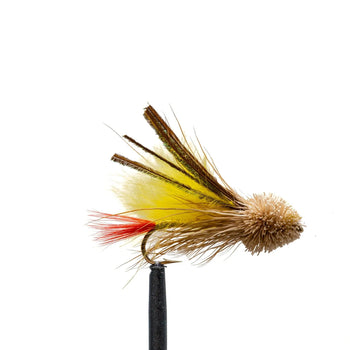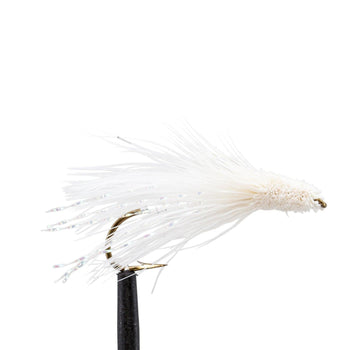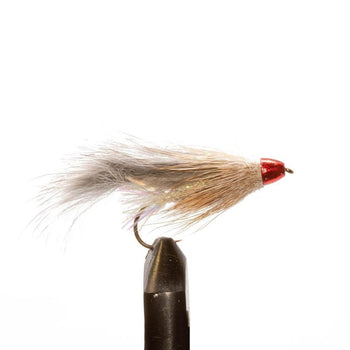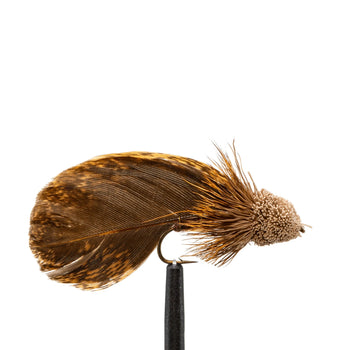Mastering the Muddler Minnow: A Versatile Pattern For Year-Round Success

In the world of fly fishing, few patterns are as revered and versatile as the Muddler Minnow. Initially crafted to imitate the sculpin—a small, bottom-dwelling fish—the Muddler Minnow has proven effective at mimicking a variety of prey, from baitfish to insects. Its innovative design, featuring a spun deer hair head, provides exceptional buoyancy and lifelike movement, making it equally effective whether fished below the surface or on top. This adaptability has solidified its place as a must-have pattern in anglers' fly boxes worldwide.
The History of the Muddler Minnow
The Muddler Minnow was first created in 1936 by Don Gapen, an angler from Minnesota, who designed it to imitate the sculpin, a common prey for larger fish. Its success was immediate, thanks to its unique ability to attract various species. The fly's distinctive deer hair head provided the perfect balance of buoyancy and erratic movement, allowing it to be fished as both a streamer and a surface fly. This groundbreaking design expanded the possibilities of fly fishing, making the Muddler Minnow one of the most adaptable and enduring patterns ever created.
Evolution of the Pattern
Over the years, the Muddler Minnow has evolved as anglers have tweaked it for various fishing environments. New variations have emerged, utilizing different materials and techniques to better mimic various prey or adapt to different water conditions. These innovations highlight the Muddler's flexibility while maintaining the core elements of its original design.
How and When to Use Muddler Minnows Effectively
One of the greatest strengths of the Muddler Minnow is its versatility. It can be fished in numerous ways, depending on the conditions and the species you’re targeting. Here are some tips on how and when to use Muddler Minnows to maximize your success on the water:
-
As a Streamer: Fish the Muddler Minnow below the surface by stripping it through the water in short, erratic bursts. This mimics the movement of a sculpin or a baitfish and can entice predatory fish like trout and bass to strike.
-
As a Surface Fly: The buoyant deer hair head allows the Muddler Minnow to be fished as a surface fly. Try skating it across the surface or letting it drift naturally in the current to imitate a struggling insect or small creature.
-
In Fast Water: The Muddler Minnow is particularly effective in fast-moving water, where its bulky profile and lively action can stand out against the turbulence. Cast upstream and let it drift down through riffles and runs, where trout are likely to be lying in wait.
-
In Low Light Conditions: Early mornings, late evenings, and overcast days are ideal times to fish a Muddler Minnow. The silhouette created by the deer hair head is easily visible to fish in low light, making it an excellent choice for these conditions.
-
For Aggressive Fish: The Muddler Minnow’s bold profile and erratic action can trigger aggressive strikes from fish, particularly during spawning seasons when fish are more territorial.
Best Fishing Conditions
Muddlers excel in both clear and slightly turbid waters. Their design makes them perfect for fall, when fish are more aggressive, but they can be effective in various conditions year-round. Early morning and late afternoon are peak times, as fish are actively feeding during these cooler parts of the day.
-
Spring: As water temperatures rise and fish become more active, the Muddler Minnow excels in rivers and streams where sculpins are common prey. Its ability to imitate various prey makes it ideal for fish recovering energy after winter.
-
Summer: In low-light conditions such as early morning or late evening, the Muddler Minnow attracts fish feeding near the surface or along the banks. Its effectiveness in fast-moving water also makes it a top choice for summer fishing.
-
Fall: Often the best season for the Muddler Minnow, fall sees fish feeding aggressively in preparation for winter. The fly's ability to imitate larger prey and provoke territorial strikes is particularly effective during spawning runs.
-
Winter: While generally less effective as fish conserve energy, the Muddler Minnow can still be useful in warmer climates or during winter thaws, especially when targeting larger, more aggressive fish.

Techniques for Effective Use
Different techniques can significantly enhance the effectiveness of Muddler flies, allowing you to adapt to various fishing conditions and the behavior of your target species. One of the most popular methods is stripping, where you retrieve the line in short, rapid pulls. This technique mimics the erratic movement of a fleeing baitfish or sculpin, which can provoke aggressive strikes from predatory fish like trout and bass. The key to successful stripping is varying the speed and rhythm of your retrieve to match the activity level of the fish. In warmer water or when fish are actively feeding, faster and more aggressive strips may be most effective, while slower, more deliberate strips can work better in cooler conditions or when fish are more lethargic.
Another highly effective technique is dead drifting, where you allow the fly to move naturally with the current, imitating a drifting insect or struggling small fish. This method requires a delicate presentation, as you want the fly to appear as natural as possible. Dead drifting is particularly effective in rivers and streams with consistent flows, where fish are accustomed to feeding on drifting prey. You can also use a technique called swinging, where the fly is allowed to arc across the current, which can be particularly effective for targeting fish holding in deeper runs or along drop-offs.
Jerking the rod tip intermittently during the retrieve can add an extra bit of lifelike action to the fly, especially when fishing in still waters or during slow retrieves. This erratic movement can simulate an injured or struggling prey, making it irresistible to opportunistic predators.
Understanding the water you’re fishing in and the behavior of the fish you're targeting is crucial for selecting the right technique. In faster currents, a heavier fly with a more aggressive retrieve might be necessary, while in slower or still waters, a more subtle approach, like dead drifting or a slow strip, may yield better results. Additionally, experimenting with different techniques during the same outing can help you determine what the fish are responding to on that particular day, giving you a better chance of success.
By mastering these techniques and adjusting your approach based on the conditions, you can maximize the effectiveness of your Muddler flies and increase your chances of landing the fish of a lifetime.
Recommended Muddler Fly Patterns
While the original Muddler Minnow remains a classic, countless variations have proven equally effective over the years. Here are the JHFLYCO Muddler patterns that every angler should consider.
-
Muddler Minnow: The classic Muddler Minnow is where it all began. Designed to imitate the sculpin, this pattern features a spun deer hair head that provides buoyancy and a lifelike, erratic movement in the water. It can be fished as a streamer by stripping it through deeper pools or used as a surface fly by skating it across the water’s surface. Its versatility makes it a staple in any angler’s fly box, particularly effective in fast-moving rivers or when targeting aggressive fish like trout and bass.
How to Use: Fish the Muddler Minnow in short, quick strips to mimic a fleeing baitfish, or allow it to drift naturally in currents to imitate a struggling insect or small fish. This fly excels in fast water and is particularly effective in low-light conditions.
-
Conehead Muddler (Various Colors: Black, White, Natural, Yellow): The Conehead Muddler is a weighted variation of the original, designed to sink quickly and get down to deeper fish. The addition of the conehead allows the fly to maintain its enticing action even at greater depths. Available in black, white, natural, and yellow, this fly is ideal for fishing in deep pools or fast-moving rivers where you need to get your fly down quickly.
How to Use: Cast the Conehead Muddler upstream and let it sink before retrieving it with short, sharp strips. The added weight ensures that the fly stays in the strike zone longer, making it particularly effective for trout holding in deep runs.
-
Marabou Muddler (Various Colors: Black, Brown, Yellow, White): The Marabou Muddler takes the classic pattern to the next level by incorporating marabou feathers, which add a seductive, pulsating movement that’s hard for fish to resist. Available in a range of colors—black, brown, yellow, and white—this fly is particularly effective in still waters, where the slow, undulating action can draw fish from a distance. It’s an excellent choice for targeting species like bass and pike in lakes and ponds.
How to Use: In still water, retrieve the Marabou Muddler with slow, steady strips, allowing the marabou to pulse and breathe naturally in the water. This subtle action can provoke strikes from fish that might ignore faster-moving patterns.
-
Muddler Minnow - Crystal White: The Crystal White Muddler is a standout variation that adds a flash of brightness to the traditional Muddler design. The crystalline effect of this pattern makes it highly visible in both clear and slightly stained waters, making it an excellent choice for targeting fish that are keying in on lighter-colored prey.
How to Use: Fish the Crystal White Muddler in clear water conditions where its bright, reflective qualities can catch the attention of fish from a distance. It’s particularly effective when fished with a quick strip retrieve to mimic the darting motion of a small baitfish.
-
Floating Muddler (Various Colors: White, Yellow, Olive, Black, Brown): The Floating Muddler is a variation that keeps the buoyant characteristics of the original but is designed specifically for surface action. Available in a range of colors—white, yellow, olive, black, and brown—this pattern is ideal for fishing on the surface, where it can imitate anything from a skittering insect to a small baitfish. The different color options allow you to match the hatch or stand out against various backgrounds depending on the fishing conditions.
How to Use: Skate or drift the Floating Muddler across the surface to mimic a struggling or fleeing insect. This pattern works particularly well during summer and early fall when fish are actively feeding on the surface. Experiment with different colors to see which one gets the most attention based on the lighting and water clarity.
-
Conehead Kiwi Muddler (Various Colors: Black, White, Natural): The Conehead Kiwi Muddler is a modern twist on the traditional pattern, incorporating vibrant colors and a flashier profile to attract attention in murkier waters. Available in black, white, and natural, this fly sinks quickly, making it perfect for targeting fish in turbid rivers or lakes, where visibility is limited.
How to Use: Use the Conehead Kiwi Muddler in stained or murky water, retrieving it with varied strips to create an erratic, attention-grabbing movement. The combination of bright colors and the added weight makes it perfect for coaxing strikes from fish in challenging conditions.
-
Matuka Muddler: The Matuka Muddler combines the traditional Muddler Minnow with the Matuka-style wing, which is tied down along the body for added durability and a streamlined profile. This pattern mimics larger baitfish and is particularly effective in rivers with strong currents, where its robust design can withstand repeated strikes from aggressive fish.
How to Use: Fish the Matuka Muddler with long, slow strips to imitate a larger baitfish swimming through the water. This fly is particularly effective when fished in deeper runs or when targeting larger predatory fish like brown trout or steelhead.
Conclusion
The Muddler Minnow and its variations are essential tools in any fly angler’s arsenal. Whether you’re fishing fast-moving rivers, still lakes, or anything in between, these patterns can help you land the fish of a lifetime. By understanding the history and versatility of the Muddler Minnow, and knowing which patterns to use and when, you’ll be well on your way to more successful days on the water.
So, next time you’re preparing your fly box, make sure you have a few of these top Muddler patterns on hand. You never know when they might save the day!
SHOP ALL MUDDLERS
RELATED ARTICLES:
- Rule the Waters This Summer with Terrestrial Flies
- 8 Late Summer Strategies for Landing the Perfect Trout
- Top 5 Summer Hatches: What Flies You Need in Your Box
- How to Choose the Right Size Fly Fishing Leader & Tippet
- Maximizing Your Fly Fishing Success: Why You Should Buy Flies in Bulk
- Essential Fly Fishing Knots: 10 Key Ties for Angling Success














